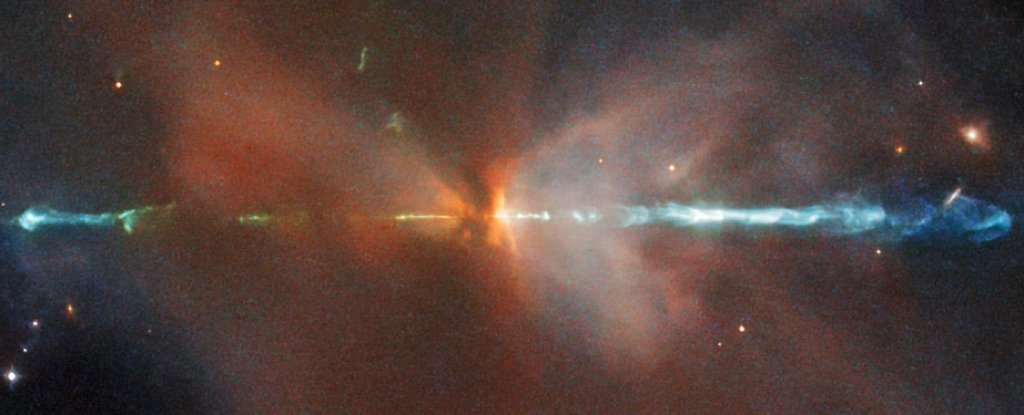
[ad_1]
A new star system 1,400 light years from Earth is revealed in all its dynamic glory in a new photo from the Hubble Space Telescope.
The system is called IRAS 05491 + 0247, and it is at the center of a particularly rare and magnificent cosmic interaction known as the Herbig-Haro object. This particular Herbig-Haro object, called HH 111, is powered by a star in a binary system, projecting powerful astrophysical jets into the surrounding space.
Herbig-Haro objects are some of the most spectacular in the galaxy, but they require a specific set of circumstances. First of all, you need a star baby. These are formed from dense clusters of matter in a molecular cloud that collapse under their own gravity and, as they spin, begin to accumulate matter from the cloud around them.
During this process, the star can project powerful jets of plasma from its poles. Some of the accretion material that swirls around the star is believed to be channeled along the star’s magnetic field lines, which accelerate the particles so that when they reach the poles, they are launched. at considerable speeds in space in the form of very tight collimated jets.
The insane temperatures involved ionize this material, turning it into plasma.
For a Herbig-Haro object, these jets, traveling at hundreds of kilometers per hour, then crash violently into the surrounding molecular cloud. When these interactions occur, the warm temperatures make the material glow – but they also change rapidly, especially on cosmic time scales, observably changing over just a few years.
 Jets emanating from HH 111. (ESA / Hubble & NASA, B. Nisini)
Jets emanating from HH 111. (ESA / Hubble & NASA, B. Nisini)
The bipolar jet HH 111 is created by one of the stars of a binary pair, located near a central torus of gas and dust that was the accretion material of stars. From each pole, a jet extends 12 light years from the star.
This star’s binary companion is also, interestingly, spitting jets, as was discovered a few years ago. It appears to be oriented perpendicular to the first star, so its smaller jets explode at right angles to the larger ones.
These objects are really bright in optical wavelengths, but the dusty environment they inhabit prevents much of that light from escaping. Instruments capable of penetrating dust – for example, imaging in infrared wavelengths – reveal details that we might not have seen otherwise. The secondary jets, discovered in 2000, were imaged this way.
 Objects in the star system. (ESA / NASA)
Objects in the star system. (ESA / NASA)
These 2000 images also revealed a third star, which appears to have been ejected from the baby system, in a kind of interaction that could help reveal why our Sun is alone and not in binary.
The new version, taken with Hubble’s Wide Field Camera 3 instrument, was imaged in a combination of optics and infrared, showing the bright jets shining through the thick dust of the molecular cloud.
You can download wallpaper versions of the Hubble image of HH 111 from the Hubble website.
[ad_2]
Source link